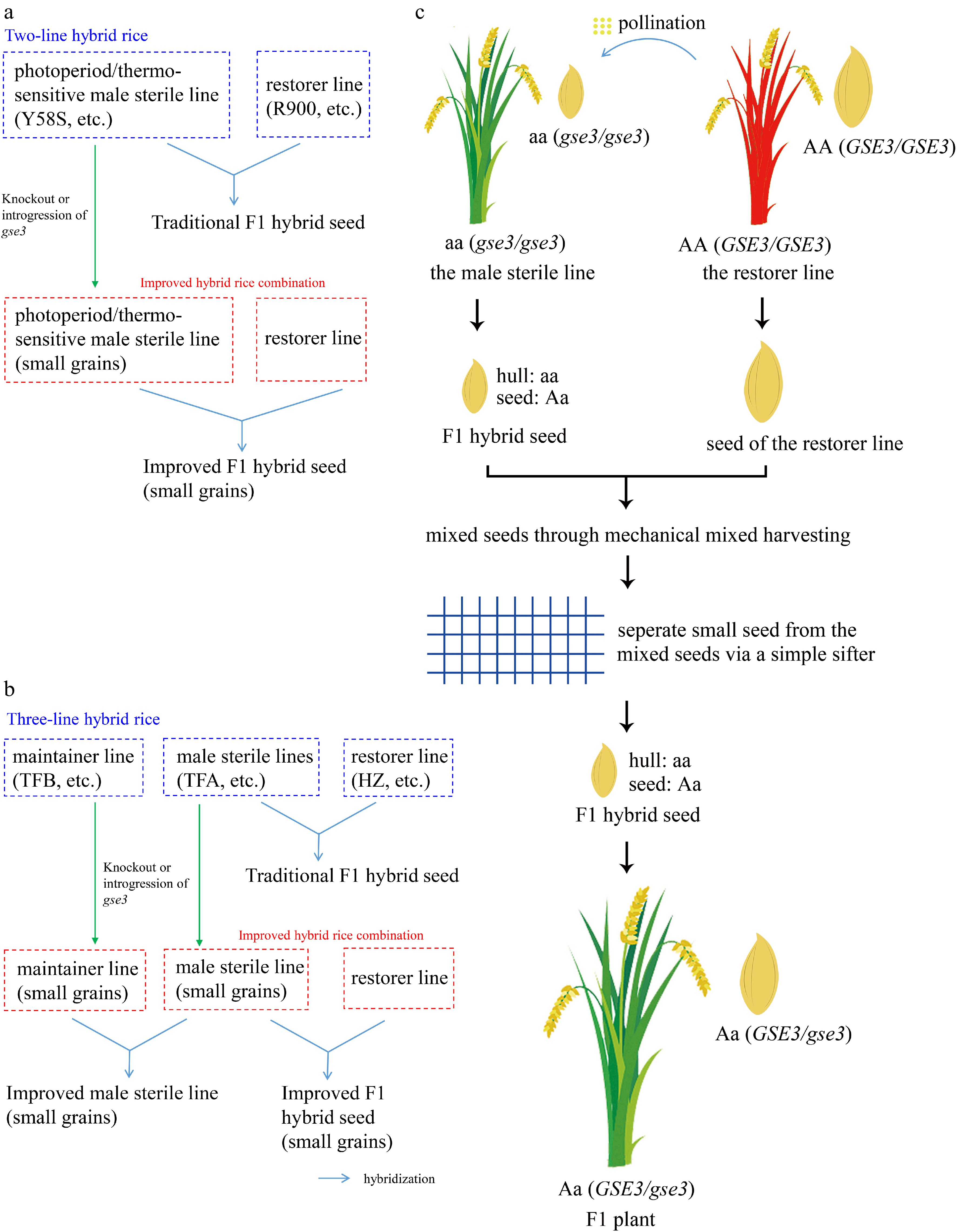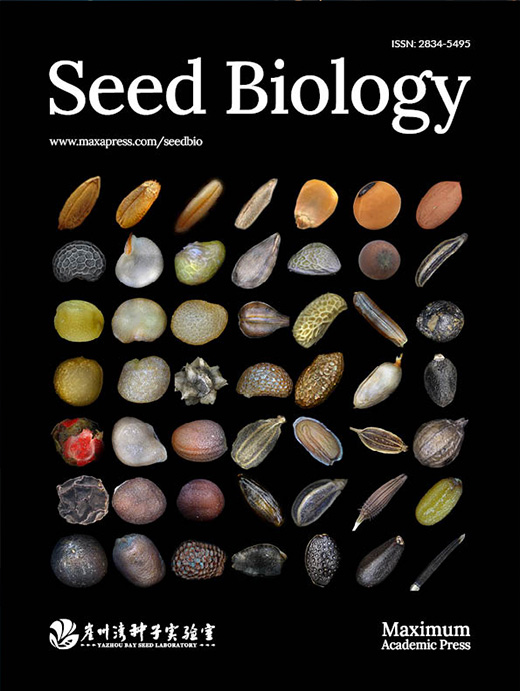-
Owing to heterosis, the F1 hybrid offspring exhibits a superior yield increase than their parents. Crop hybrid technology is one of the most effective ways to utilize heterosis. Hybrid rice leads a revolution in yield improvement[1], and has a significant contribution to food security. Benefit to the significant yield advantage, the annual planting area of hybrid rice accounts for about half of the total rice area in China, and is being promoted worldwide. Currently, the widely used hybrid rice breeding method includes a three-line and two-line system. Both of which need cross male sterile lines with restorer lines to obtain F1 hybrid seeds for field production in the next plant season. Still, F1 hybrid seed production includes several manual steps[2], and the steps sre complicated and labor-intensive. Moreover, the yield of F1 hybrid seed is usually quite low. These result in high costs for hybrid seed production and difficulty in controlling hybrid seed purity and thereby affect its further promotion. Thus, the strategy for enabling fully mechanized hybrid seed production is urgently needed.
Currently, several strategies have been proposed for mechanical hybrid seed production[3,4]. Therein, mixed planting of male sterile line and restorer lines, and then mechanized harvesting and hybrid seed sorting is feasible for F1 hybrid seed production[5]. (1) Introducing bentazon-sensitivity into the restorer line or Basta-resistance genes into the male sterile line, will permit removing the restorer line by spraying herbicide after pollination. (2) By utilizing the female sterility in the modified restorer line, the male sterile lines can be pollinated for F1 hybrid seed production, while the modified restorer line has no self-pollination and no seed needs to be removed[6]. (3) Difference in hull colors between the male sterile line and the restorer line can be exploited to separate hybrid seeds from the mixed seeds of parental lines using the specific optoelectronic color selection device. (4) Developing the male sterile line with small grains and the restorer line with large grains, the significant differences in seed size enable mechanical separation of small F1 hybrid seeds from mixed seeds of parental lines by using a simple sifter[4,7,8].
However, these strategies are stuck in the research stage and have not been applied in large-scale industrialization. Notably, currently a series of hybrid combinations have been bred using traditional breeding by several research groups, accomplishing hybrid seed sorting based on grain size[4], which is lengthy and laborious. Whereas genetic modulation using appreciate gene resources could accomplish rapid improvement of current hybrid rice, for example, tfs1/ago7 for female sterility[6]. Furthermore, mechanized hybrid rice seed production based on grain size may have better advantages. For example, avoiding the loss of the restore line seeds, as well as, the demand for hybrid seed production is for a larger number of seeds, without paying attention to seed size. Grain size and grain number per plant are two major traits determining the sink capacity of individual plants, exiting a compensation mechanism[9]. In rice, the grain grows inside the spikelet hull which limits grain growth. In this case, it is the maternal genotype but not the zygote genotype determining grain size[10]. Currently, the cloned grain size genes provide insights into the regulatory pathway[11]. However, most grain size genes have pleiotropy, for example, the MAPK signaling often controls both grain size and grain number[12]; therefore, it is necessary to finely classify their effect on grain size and other agronomical traits. Although several cloned genes play positive effect on grain size, loss-of-function in some of these genes cannot form small grains, for example, GS2. While manipulation of the remaining genes can reduce grain size, they usually have negative effects on other agronomic traits.
Therefore, a promising approach to achieve this goal is to find grain size genes or alleles, causing small grains and more grains in male sterile lines, for example, the first identified TGW5. TGW5FH212 encodes a weak allele of D1, an SNP in the splice site which produces a partially functional protein, showing potential for mechanized hybrid seed production. However only accurately editing the SNP can rapidly improve the male sterile lines[13]. However, the grain size gene should have the following features. The small-grain phenotype should be determined by a recessive allele, and this recessive allele should influence grain size through maternal tissues in the mother plant. Otherwise, the small grain allele in F1 plants will affect the grain size of hybrid rice, and decrease the grain yield. In a word, the combination should also have no penalties in the F1 heterosis. Besides, the hybrid seeds and restore line seeds should have significant differences in grain size, thus to ensure effective seed sorting. In practice, the grain size is actually in a range even on the same panicle. The underlying suggestion is that the maximum size of the hybrid seeds should be lower than the minimum size of the restore line seeds.
Recently, an interesting study by Huang et al. reports that the recessive gse3 allele in male sterile lines gives small grain size and increased seed number, allowing hybrid seeds to be separated from restorer seeds via a simple sifter. Therefore, it is a significant advance for rapidly improving current male sterile lines, enabling fully mechanized F1 hybrid seed production[14].
In more detail, after 10 years of effort, the group led by Prof. Yunhai Li has successfully bred a male sterile–restorer combination XQA–DHZ based on an elite hybrid rice. The combination shows small F1 hybrid seeds that could be efficiently separated from mixed seeds, can increase hybrid seed number, and do not decrease the final hybrid rice yield. To identify the mutation that is responsible for the small-grain phenotype in XQA and XQB, a cross between Zhonghua11 and XQB was conducted, and the target gene grain size on chromosome 3 (GSE3) was identified, and a series of analyses confirmed that GSE3 gene is LOC_Os03g55530. Concurrently, they performed a large-scale mutagenesis screen to identify genes for breeding ideal small-grain male sterile lines and isolated the m238 mutant, showing a similar phenotype with gse3 plants. Interestingly, the causal gene for the m238 mutant is a new allele of GSE3. This coincidence also suggests the rarity of GSE3. Mechanistically, GSE3 encodes a GCN5-related N-acetyltransferase-like protein with a conserved GNAT motif localized in the nucleas, which can bind histones and influences histone acetylation levels, similar to GW6a. GSE3 interacts physically and genetically with GS2/OsGRF4 and OsGRF3. The transcription factor OsGRF4 recruits GSE3 to bind the promoters of their co-regulated genes, and then activates their expression by influencing the histone acetylation status.
After identifying GSE3 as an ideal small grain size gene, and considering that the male sterile line and restorer line of current hybrid combinations have similar grain size, a very exciting trial was conducted. CRISPR/Cas9 knockout GSE3 in male sterile line Y58S for two-line hybrid rice variety YLY900, and in male sterile line TFA and the maintainer line TFB for three-line hybrid rice variety TYHZ, could accomplish mechanized hybrid seed production (Fig. 1a, b). Meanwhile, GSE3small grain allele (loss-of-function) is a rare allele in the 3024 tested rice varieties suggesting its huge application space.

Figure 1.
A strategy to rapidly improve current hybrid rice for fully mechanized F1 hybrid seed production. (a), (b) CRISPR/Cas9 editing GSE3 accomplish rapidly improved current hybrid rice combinations for mechanized hybrid seed production. (c) Schematic diagram of fully mechanized production of F1 hybrid seeds.
In conclusion, Huang et al. successfully modulated grain size GSE3 in several hybrid combinations, and therefore demonstrated a potentially ideal strategy for fully mechanized hybrid seed production (Fig. 1c)[14]. GSE3 positively regulates grain size and negatively influences grain number, while grain number is important for hybrid seed number in hybrid seed production. However, the molecular mechanisms whereby GSE3 regulates these traits remain unclear. Uncovering these mechanisms will provide insight into how plants coordinate grain size and grain number and optimize the use of GSE3. Seed size is thought as an important physiological factor in seed vigor or seedlings emergence[15], suggesting some potential influence on hybrid seeds need to be noted. Therefore, further research efforts are required to reveal more optimized alleles coordinating grain size and number. We believe that by appropriate genetic modulation of grain size and number, the fully mechanized hybrid rice breeding will come true, which also establishes a foundation for other important crops.
HTML
-
Zhao D and Liu Q organized and wrote the manuscript. Both authors reviewed and approved the final version.
-
Data sharing is not applicable to this article as no datasets were generated or analyzed during the current study.
This work was supported by the Programs from Jiangsu Province Government (23KJA210001 and BM2022008-02).
-
The authors declare that they have no conflict of interest. Qiaoquan Liu is the Editorial Board member of Seed Biology who was blinded from reviewing or making decisions on the manuscript. The article was subject to the journal's standard procedures, with peer-review handled independently of this Editorial Board member and the research groups.
- Copyright: © 2024 by the author(s). Published by Maximum Academic Press on behalf of Hainan Yazhou Bay Seed Laboratory. This article is an open access article distributed under Creative Commons Attribution License (CC BY 4.0), visit https://creativecommons.org/licenses/by/4.0/.
| Zhao D, Liu Q. 2024. Elite grain size gene enables fully mechanized hybrid rice seed production. Seed Biology 3: e011 doi: 10.48130/seedbio-0024-0011 |













